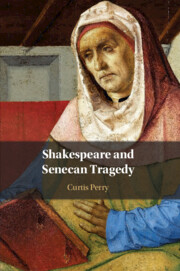Book contents
- Shakespeare and Senecan Tragedy
- Shakespeare and Senecan Tragedy
- Copyright page
- Contents
- Acknowledgments
- Note on Texts
- Chapter 1 Shakespeare and the Resources of Senecan Tragedy
- Chapter 2 Richard III as Senecan History
- Chapter 3 Seneca and the Modernity of Hamlet
- Chapter 4 Seneca and the Antisocial in King Lear
- Chapter 5 Republican Coriolanus and Imperial Seneca
- Chapter 6 Seneca, Titus, and Imperial Globalization
- Chapter 7 Senecan Othello and the Republic of Venice
- Bibliography
- Index
Chapter 4 - Seneca and the Antisocial in King Lear
Published online by Cambridge University Press: 06 October 2020
- Shakespeare and Senecan Tragedy
- Shakespeare and Senecan Tragedy
- Copyright page
- Contents
- Acknowledgments
- Note on Texts
- Chapter 1 Shakespeare and the Resources of Senecan Tragedy
- Chapter 2 Richard III as Senecan History
- Chapter 3 Seneca and the Modernity of Hamlet
- Chapter 4 Seneca and the Antisocial in King Lear
- Chapter 5 Republican Coriolanus and Imperial Seneca
- Chapter 6 Seneca, Titus, and Imperial Globalization
- Chapter 7 Senecan Othello and the Republic of Venice
- Bibliography
- Index
Summary
King Lear is structured by a surprisingly comprehensive and sustained engagement with Senecan tragedy. The play is about the collapse of society, and the antisocial nature of Senecan tragedy is its major intertextual resource for thinking about the tragic self in relation to community. The play’s first two acts draw heavily on Senecan language to imagine Lear’s furious response to his daughter’s independence. The middle portion of the play, especially the part with Lear in the storm, interrogates a style of high-flown Senecan rhetoric as the voice of a tragic brand of solipsism. The final movement of the play draws heavily on scenes of fraught and partial reconciliation in Seneca’s Hercules Furens and Phoenissae. Since the 1960s, King Lear has been celebrated as the preeminent dramatic representation of deracinated modern subjectivity, at once uplifting and corrosively skeptical. The play has come to be seen as a representative example of the type of modernist allegory Benjamin finds in Trauerspiel – as a representation of what it means to be human after having lost the ability to feel like part of any larger whole. But since Shakespeare achieves this via Seneca, it may be worth revisiting how modern the perspective actually is.
- Type
- Chapter
- Information
- Shakespeare and Senecan Tragedy , pp. 110 - 151Publisher: Cambridge University PressPrint publication year: 2020



